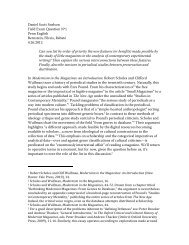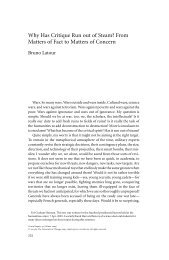The Exploit: A Theory of Networks - asounder
The Exploit: A Theory of Networks - asounder
The Exploit: A Theory of Networks - asounder
You also want an ePaper? Increase the reach of your titles
YUMPU automatically turns print PDFs into web optimized ePapers that Google loves.
28 Nodes<br />
material and immaterial, as simultaneously technical and political, as<br />
simultaneously misanthropic and all - too - human.<br />
Let us continue then not with an empirical observation but with a concept.<br />
Derived from the discourses <strong>of</strong> both the life sciences and computer<br />
science, the concept <strong>of</strong> “protocol” refers to all the technoscientific rules<br />
and standards that govern relationships within networks. Protocols abound<br />
in technoculture. <strong>The</strong>y are rooted in the laws <strong>of</strong> nature, yet they sculpt the<br />
spheres <strong>of</strong> the social and the cultural. <strong>The</strong>y are principles <strong>of</strong> networked inter -<br />
relationality, yet they are also principles <strong>of</strong> political organization.<br />
Quite <strong>of</strong>ten networked relationships come in the form <strong>of</strong> communication<br />
between two or more computers, but the relationships can<br />
also refer to purely biological processes, as in the systemic phenomenon<br />
<strong>of</strong> gene expression or the logics <strong>of</strong> infection and contagion. Protocol<br />
is not a single thing but a set <strong>of</strong> tendencies grounded in the<br />
physical tendencies <strong>of</strong> networked systems. So by “networks” we mean<br />
any system <strong>of</strong> interrelationality, whether biological or informatic,<br />
organic or inorganic, technical or natural—with the ultimate goal <strong>of</strong><br />
undoing the polar restrictiveness <strong>of</strong> these pairings.<br />
Abstracted into a concept, protocol may be defined as a horizontal,<br />
distributed control apparatus that guides both the technical and<br />
political formation <strong>of</strong> computer networks, biological systems, and other<br />
media.<br />
Molecular biotechnology research frequently uses protocols to con -<br />
figure biological life as a network phenomenon, whether in gene expression<br />
networks, metabolic networks, or the circuitry <strong>of</strong> cell signaling<br />
pathways. In such instances, the biological and the informatic<br />
become increasingly enmeshed in hybrid systems that are more than<br />
biological: proprietary genome databases, DNA chips for medical diag -<br />
nostics, and real - time detection systems for biowarfare agents. Likewise<br />
in computer networks, science pr<strong>of</strong>essionals have, over the years,<br />
drafted hundreds <strong>of</strong> protocols to create e - mail, Web pages, and so<br />
on, plus many other standards for technologies rarely seen by human<br />
eyes. An example might be the “Request for Comments” series <strong>of</strong><br />
Internet white papers, the first <strong>of</strong> which was written by Steve Crocker<br />
in 1969, titled “Host S<strong>of</strong>tware.” 3 Internet users commonly use proto-









